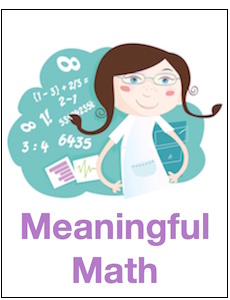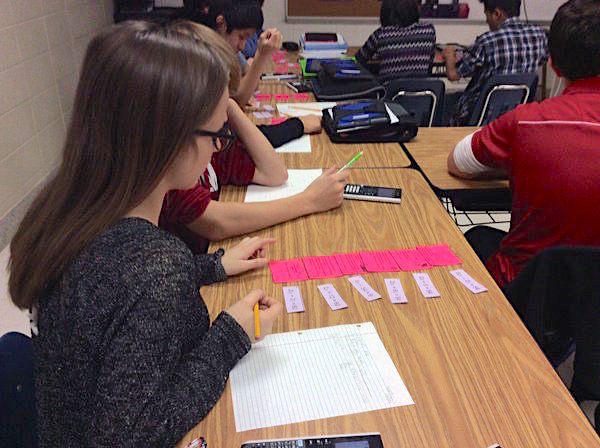Have Fun Taking Math Beyond Direct Instruction
A MiddleWeb Blog
 I recently wrote about being in a teaching rut. I was trying to “cover” material, and the students’ learning experience was limited to mostly direct instruction and taking notes. Unsurprisingly, it wasn’t very engaging for my students or enjoyable for me.
I recently wrote about being in a teaching rut. I was trying to “cover” material, and the students’ learning experience was limited to mostly direct instruction and taking notes. Unsurprisingly, it wasn’t very engaging for my students or enjoyable for me.
Part of the problem was that direct instruction doesn’t allow for a lot of student engagement, but I think there is more to it.
My students were bored with doing the same thing every day. I hadn’t provided them with any variety, and they became disengaged. Students need structure, but that doesn’t mean monotony.
Planning Ahead
I thought a lot about this over Christmas break. When we returned, I was energized and determined to do better going forward. I wanted to make sure that I implemented a variety of activities for my next unit. Fortunately, when we came back to school from the break, we had a day to work in our room with no students.
I spent the entire day planning activities for my upcoming unit in Algebra 2 with Trig – Polynomials. I have taught this unit several times before, but I still spent about six hours finding and creating activities for my students. Spending a whole day seems like a lot, but finding activities that are useful and fun and also further students’ understanding is a tall order.
If you’re a middle school math teacher (and you probably are) I realize that you may not be teaching higher level polynomials. But while that’s my context, I think a lot of what I’m learning about engagement in math class carries over to the upper middle grades – at least!
Variety of Activities = More Student Engagement
I was able to incorporate a variety of experiences, some technological and some old school. We played games, did card sorts and explored new topics on Desmos. On a few days, there was direct instruction and students took notes. The end result was much better with this unit.
My students were more engaged and involved. There was discussion and students were talking about math with each other. It was more enjoyable for me and my classes. In fact, on a couple of days, a few students told me they had fun! I have shared below some of what we did, along with links to the resources where possible.
Playing Games – “Simon Says” Teaches End Behavior
Part of my unit involved teaching end behavior of polynomials, and I remembered a great article I read several years ago, How I Sextupled the Time it Takes to Teach End Behavior. It’s a great resource which involves a card sort and student discovery. It allows students to determine end behavior via the card sort without being explicitly told. The author suggested concluding the lesson by playing music and having students mimic end behavior with their arms.
I liked that idea but I wanted to play a game. So we played Simon Says with end behavior: I would say “even, positive” (if you don’t know about end behavior this won’t make a lot of sense to you) and they would raise both arms up—but only if I said Simon Says! The last three people standing were our winners. We had a lot of fun and students asked to play for days afterward. Even better, on the day of the test I saw students making the arm motions to determine end behavior.
You can probably think of ways to adapt this simple “Simon Says!” activity to reinforce other math processes. (Nervous about letting your students get up and move around? See this recent post here at MiddleWeb by teacher educator Curtis Chandler. There’s a big payoff!)
Desmos – tech fatigue?
I’ve mentioned Desmos many times before because I think it’s a great resource. For this unit, I used a Desmos activity to introduce how to find zeros. This activity is designed to “help students explore connections between polynomial equations in factored form and their zeroes.” It is a really good activity because it drives home the relationship between the factors and the zeros.
But it was really disappointing to me that my students didn’t enjoy it more. I thought they would really like it, but I found that they were a little underwhelmed. I think it’s a case of technology fatigue. Our students have their personal chromebooks and in almost every class they use technology in some way, and I think they get a little burned out on it.
Card Sort
In this unit I did two card sorts, one to teach end behavior and one to review exponent rules. I’m always surprised how well students respond to card sorts. I’m afraid they’ll find them boring, but my students in general seem to like them and, more importantly, to learn from them.
I love walking around listening to their conversations and seeing how they sort their cards. I think that students are drawn to them because it is a change of pace and it’s something they can do with their hands as opposed to using their Chromebooks.

I began to really explore card sorts about five years ago.
The only issue with card sorts is having to cut out the cards! It can take an hour or more to cut out a set of cards. Of course, you can laminate them and use them again. Or, if you don’t want to deal with cutting out cards, there is a Desmos activity that is very similar to the card sort I used to review exponent rules. Find examples here:
Card Sort from misscalcul8 (card sort to review exponent rules)
Exponent Card Sort from Desmos
Ms. Hagan’s Book of Exponent Rules from Math = love
Direct Instruction
I admit there were days when I felt like direct instruction was appropriate. I personally find that direct instruction can sometimes be the best choice. In fact, many of my students tell me that they enjoy the structure of lecture and notes if it’s not done every day. So, while we may not think of direction instruction as “engaging,” using it strategically may end up feeling like a novelty to students!
Final thoughts
Providing students with a variety of experiences right after Christmas break kept them engaged. It also provided shared learning experiences for my class. Plus, it made me excited about teaching. It’s fun for me to try new activities, and also a little nerve wracking. Even if some activities went over better than others, there was something for everybody.
It is also a fact that finding a variety of activities takes a great deal of time. It took a couple of hours just cutting out the cards for the card sorts. It would have taken even longer if there weren’t teachers on the Internet who are willing to post their activities for all to use, and I appreciate their dedication and hard work.
I have listed below the places I go to consistently find good ideas and activities. Please share any resources or activities that you find add variety to your classroom in the comments below.
Favorite Places to Go for Resources
Set The Hook The MTBoS Search Engine
https://mathequalslove.blogspot.com/
square root of negative one teach math
Twitter hashtags: #MTBoS, #mathchat, #msmathchat #iteachmath
What are your favorites?




































I’m curious about the tech fatigue response to Desmos. As an early activity did it seem gimmicky? Were they conversing less with each other than in other activities, like the card sort?
The activity didn’t seem gimmicky, it actually does a good job of showing the graphical relationship between factors and zeros. It’s just that students didn’t really respond to it as well as I thought they would. Each student did this activity individually on their chromebook, so they weren’t talking with each other very much. (I’ve linked the activity below if you want to look at it).
https://teacher.desmos.com/activitybuilder/custom/561c13ad9d96f9420935709b